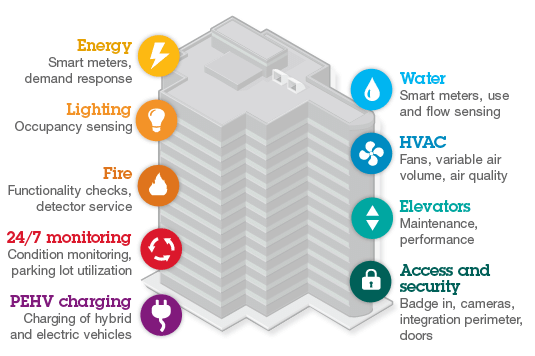So why should you care about smart building solutions?
For one thing, they can help reduce your carbon footprint by cutting down on energy consumption (which is good for both your bottom line and the environment).
Additionally, smart building solutions often improve indoor air quality and provide greater control over the indoor environment, making it more comfortable for occupants.
Table of Contents
Design and Construction of Smart Buildings
There is no single blueprint for creating a smart building – but there are many available technology solutions that can be used to make a building more efficient, more comfortable, and more sustainable.
The key is to take a holistic and integrated approach to design and construction, using a range of smart building solutions that are appropriate for the specific building and its occupants.
Here are some of the most popular smart building solutions for facility managers and owners.
1. Automated Lighting Systems
These systems use sensors to detect when a space is occupied and adjust the lighting accordingly. This can result in significant energy savings as well as improved workplace experience.
2. Building Management Systems
These systems help to optimize the performance of a building by monitoring and controlling a range of systems including heating, ventilation, and air conditioning (HVAC).
3. Intelligent Window Glazing
This is a type of glass that has been designed to regulate the amount of heat and light that enters a building. This can help to improve the thermal comfort of occupants and reduce the need for artificial lighting and cooling.
4. Solar Power
Solar power is a renewable energy source that can be used to generate electricity, either for the whole building or for specific systems such as lighting or HVAC.
5. Wind Power
Like solar power, wind power is a renewable energy source that can be used to generate electricity. Wind turbines can be installed on the roof of a building or on a nearby site.
6. Geothermal Energy
This is a type of renewable energy that uses the earth’s heat to generate electricity or to heat and cool a building for an improved workplace experience.
7. Water Conservation
There are a number of ways to reduce the amount of water used in a building, such as using low-flow fixtures and appliances, harvesting rainwater, and recycling greywater.
8. Recycling and Waste Management
Smart buildings often have systems in place to encourage occupants to recycle and reduce the amount of waste generated. This can include on-site recycling facilities, composting systems, and waste segregation.
The above are just a few examples of smart building solutions – there are many others that can be used to create a more sustainable and comfortable environment for occupants.
Smart Building Management Systems
If you manage a building, you know that there are a lot of systems in place to keep things running smoothly. There’s the HVAC system to regulate temperature, the security system to keep everyone safe, and the plumbing system to, well, keep the water flowing.
But what ties all of these systems together?
For most buildings, the answer is a building management system or BMS.
A BMS is a computer-based system that monitors and controls the various systems within a building. It can do everything from regulating the temperature to keeping an eye on the security cameras.
But what makes a BMS “smart”?
In recent years, there’s been a push to make building management systems more than just a way to keep track of what’s going on in a building. The goal is to make them more proactive so that they can predict and even prevent problems before they happen.
To do this, smart building solutions make use of data analytics and artificial intelligence. By collecting data from the various systems within a building, a smart BMS can identify patterns and trends.
For example, let’s say that the data shows that the HVAC system is being used more heavily during the day than at night. The BMS can use this information to adjust the temperature during the day so that the system doesn’t have to work as hard (and use as much energy).
Or, let’s say that the data shows that the security system is being triggered more often during the evening hours. The BMS can use this information to adjust the lighting in the building or add more security cameras in areas that seem to be causing problems.
Smart building solutions are still in their early days, but the potential is huge.
By making building management systems more proactive, we can not only improve the efficiency of the systems within a building but also prevent problems before they happen.

(Source)
Integration of Building Information Modeling (BIM)
If you’re in the construction industry, then you’re probably familiar with building information modeling (BIM). For those who aren’t, BIM is a process that uses digital models to create a virtual representation of a project.
This allows for better coordination between different disciplines, which leads to a more efficient construction process. One of the benefits of BIM is that it can be used to create “smart” buildings.
By integrating BIM with other systems, such as energy management and security, buildings can be designed and operated more efficiently.
For example, BIM can be used to create a model of a building’s HVAC system. This can then be used to optimize the system for energy efficiency.
There are many other potential applications of BIM for smart buildings.
BIM can be used to create models of people flow in a building. This can be used to improve the building’s layout and design, as well as to identify potential bottlenecks.
BIM is already having a transformative effect on the construction industry. As technology continues to develop, the potential for smart buildings will only increase.
The Internet of Things (IoT) in Smart Building Solutions
The Internet of Things (IoT) is becoming increasingly popular in a variety of industries, and the smart building sector is no exception.
By connecting various devices and systems within a building, the IoT can enable a range of benefits such as improved energy efficiency, better asset management, and enhanced security.
While the potential of the IoT in smart buildings is significant, there are also a number of challenges that need to be addressed.
One is ensuring that data is properly collected and managed.
Another is keeping IoT devices and systems safe and secure.
Despite the challenges, the IoT offers a huge opportunity for smart buildings to become more efficient and effective.
By leveraging the power of the IoT, smart building solutions can help to make our built environment more sustainable and efficient.
Big Data Analytics for Smart Buildings
Every day, we generate mountains of data that can be used to improve our lives and the way we live them.
In the past, this data was often left unanalyzed and unused. However, with the advent of big data analytics, we can now harness this data and use it to our advantage.
One way we can do this is by using big data analytics to create smart building systems. Smart buildings can collect data about their occupants and use this data to improve the experience of those occupants.
For example, a smart building might use data about the times of day when people use certain rooms to adjust the temperature or lighting in those rooms.
Big data analytics can also be used to improve the security of a smart building. By analyzing data about the movements of people within a building, it is possible to identify patterns that could indicate a security risk.
For example, if someone is repeatedly going to a certain room that they don’t normally visit, this could be an indication that they are up to something suspicious.
There are many other ways in which big data analytics can be used to improve smart buildings. By harnessing the power of big data, we can make our buildings more efficient, more secure, and more comfortable.
Frequently Asked Questions
What is an example of smart building systems?
A smart building is a structure that uses technology to manage energy use, optimize occupant comfort, and improve overall operational efficiency.
Smart building solutions allow for the automation and management of a variety of building functions including heating, cooling, lighting, security, and energy use.
What are the three basic components of a smart building?
The three basic components of a smart building are:
- A network of sensors and devices that collect data about the building and its occupants.
- A central control system uses this data to manage building systems.
- A user interface that allows occupants to interact with the control system.
What are smart buildings IoT?
Smart buildings IoT are a type of smart building solution that uses the Internet of Things to connect various devices and systems within a building in order to make it more efficient and easier to manage.
Conclusion
Overall, smart building solutions are a great way to improve the efficiency of your construction project while also reducing your carbon footprint.
If you’re looking for ways to save money and be more environmentally friendly, this is definitely something to consider!





